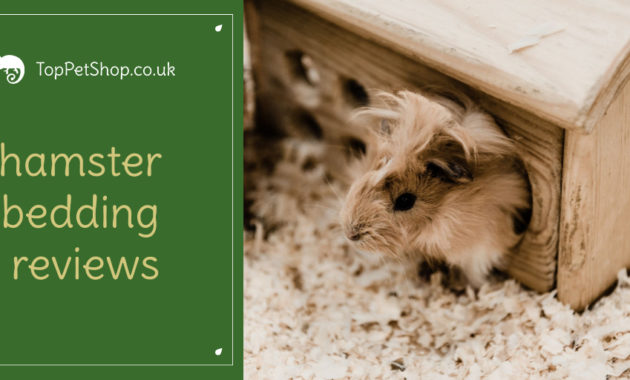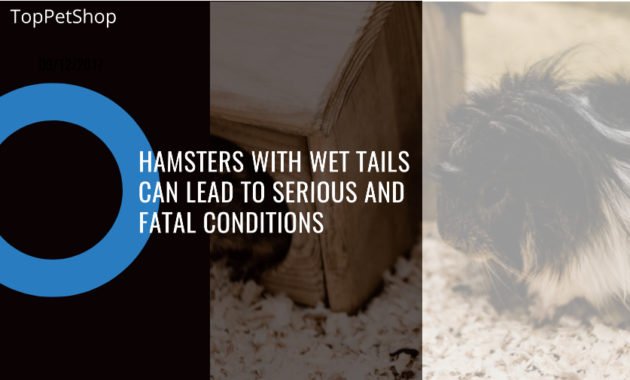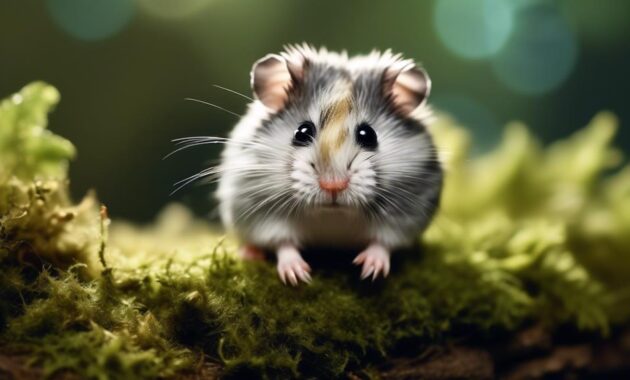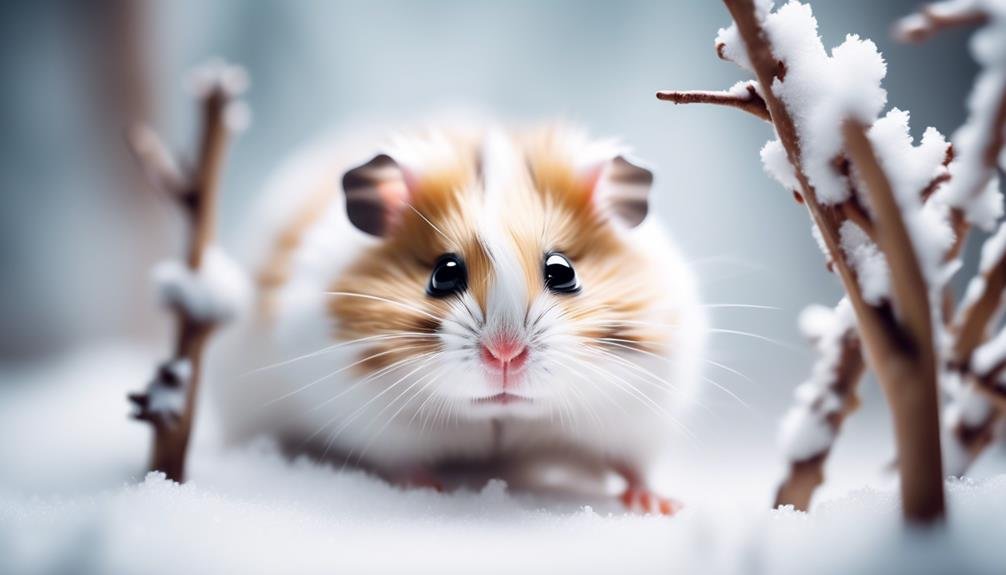
The winter white dwarf hamster, a captivating creature known for its ability to change the color of its fur, has long fascinated researchers and enthusiasts alike.
Native to the harsh conditions of Dzungaria in Central Asia, this small mammal has evolved unique adaptations to survive in its environment. From its dark grey dorsal stripe and furry feet to its elaborate burrow systems, the winter white dwarf hamster has developed various strategies to protect itself from predators.
However, its most remarkable defense mechanism lies in its ability to change its fur color, allowing it to seamlessly blend into its snow-covered surroundings.
As we explore the elusive nature of this hamster’s predator evasion tactics, we will uncover the secrets behind its remarkable adaptability and the ongoing efforts to understand and conserve this captivating species.
Key Takeaways
- Winter white dwarf hamsters have a unique fur color change during winter, transitioning from dark to white, allowing them to camouflage in snow-covered environments and evade predators.
- They are native to Dzungaria in Central Asia, specifically Kazakhstan, Mongolia, and China, and are distinct species from Campbells dwarf hamsters.
- These hamsters have a smaller size compared to Syrian hamsters, with males weighing between 19-45 grams and females weighing between 19-36 grams.
- In the wild, they utilize survival strategies such as burrowing with multiple entrances lined with moss, habitat selection in wheat fields, meadows, and birch stands, and leveraging their small size and camouflage abilities to evade predators.
Naming and Geographic Origin
The winter white dwarf hamster, also known as the Russian dwarf hamster, derives its common names from its fur color change during the winter and its geographic origin in Dzungaria. This small rodent is often confused with the Campbells dwarf hamster, but they are distinct species.
The winter white hamster’s fur color changes from dark to white during the winter, providing effective camouflage in snow-covered environments. Its binomial name is Phodopus sungorus, and it is native to Dzungaria, an area encompassing parts of Kazakhstan, Mongolia, and China.
In the wild, these hamsters inhabit wheat fields, meadows, and birch stands, using burrows with multiple entrances lined with moss for protection. They have adapted to evade predators such as weasels and have furry feet to protect themselves from the cold ground.
Physical Characteristics
Winter white dwarf hamsters, also known as Russian dwarf hamsters, exhibit distinct physical characteristics that set them apart from other species. These characteristics include:
- Size: Winter white dwarf hamsters are half the size of Syrian hamsters, making them small and compact.
- Dorsal Stripe: They have a thick, dark grey dorsal stripe that runs along their back, which helps with camouflage in their natural habitats.
- Fur Color Change: Winter white dwarf hamsters have the unique ability to change the color of their fur from dark to white in winter. This adaptation helps them blend in with the snow-covered environment and evade predators.
These physical characteristics contribute to the winter white dwarf hamster’s survival in its natural habitat and make it an interesting and unique species to study and care for.
Weight, Lifespan, and Fur Changes
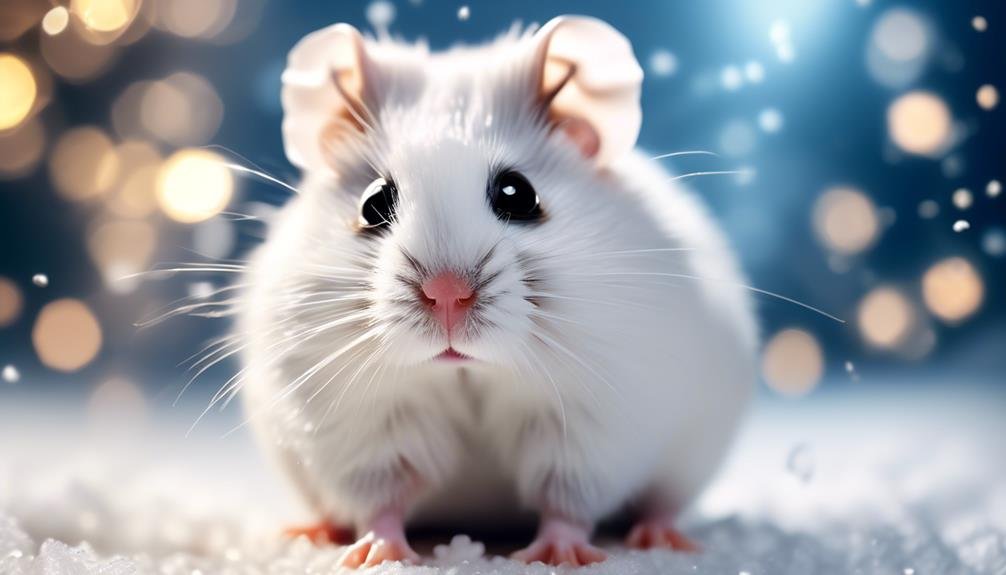
Weight, lifespan, and fur changes are important factors to consider when understanding the winter white dwarf hamster.
In terms of weight, males typically range between 19-45 grams, while females range between 19-36 grams.
As for lifespan, these hamsters have an average lifespan of 1-3 years in captivity, although some individuals have been known to live longer.
The fur of the winter white dwarf hamster undergoes significant changes throughout the year. During winter, their fur density increases, providing better insulation against the cold.
Additionally, their fur changes from ash-grey to dark brown in the summer months. These fur changes, along with their small size and camouflage abilities, aid in their survival and evasion of predators in their natural habitat.
In the Wild
During their time in the wild, winter white dwarf hamsters utilize their unique fur color change and adaptability to evade predators and thrive in their snowy habitats. These small rodents have developed several strategies to increase their chances of survival:
- Camouflage: The winter white dwarf hamster’s ability to change the color of its fur from ash-grey to white during the winter months helps it blend in with the snow-covered surroundings, making it difficult for predators to spot them.
- Burrowing: These hamsters create burrows with multiple entrances and line them with moss for insulation. This provides them with shelter and protection against predators.
- Habitat selection: Winter white dwarf hamsters typically inhabit wheat fields, meadows, and birch stands, where they can find ample food and cover.
Pet Ownership and Conservation
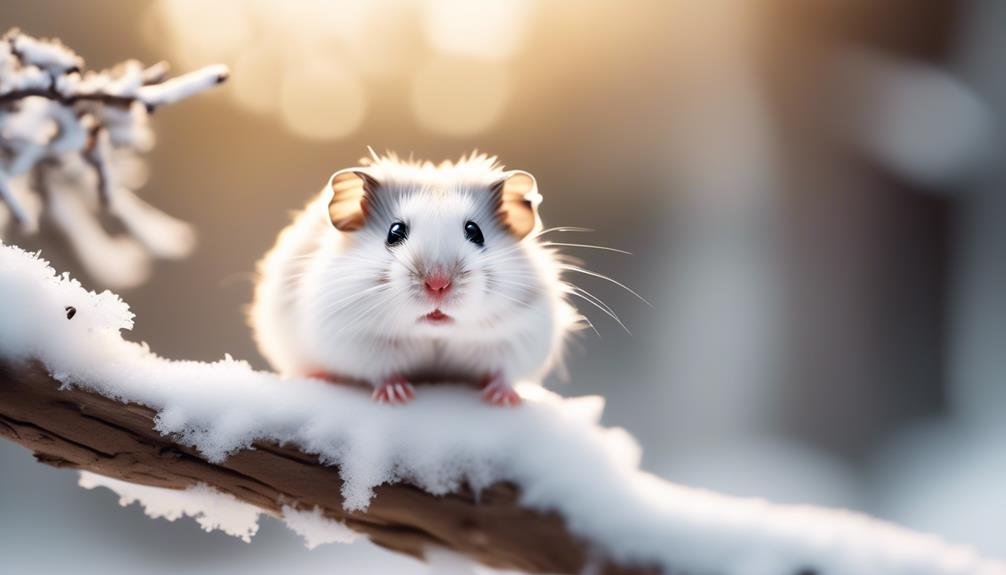
Pet Ownership and Conservation is an important aspect to consider when it comes to the care and preservation of the winter white dwarf hamster. This popular pet is kept in Europe, Japan, and North America, and its care is similar to other Phodopus species. However, there are certain health issues that owners should be aware of, including tumors, cheek pouch injuries, bite wounds, and dental problems. The availability of winter white dwarf hamsters on the pet market is also a factor to consider. In terms of conservation, the species is currently classified as “Least Concern” by the IUCN due to its large population and distribution size, with no major or widespread threats known.
| Pet Ownership and Conservation | |||
|---|---|---|---|
| Popular as pets in | Europe | Japan | North America |
| Health issues | Tumors | Cheek pouch injuries | Bite wounds, dental problems |
| Availability on pet market | – | – | – |
Frequently Asked Questions
What Is the Natural Habitat of the Winter White Dwarf Hamster?
The natural habitat of the winter white dwarf hamster, also known as the Russian dwarf hamster, includes wheat fields, meadows, and birch stands in its native region of Dzungaria. It is known for its fur color change in winter, which helps it evade predators.
How Does the Winter White Dwarf Hamster Change Its Fur Color?
The winter white dwarf hamster changes its fur color as a survival mechanism. In winter, its fur turns from ash-grey to white, providing camouflage in snow-covered environments. This helps the hamster evade predators and increase its chances of survival.
What Are Some Common Health Issues That Winter White Dwarf Hamsters May Face?
Some common health issues that winter white dwarf hamsters may face include tumors, cheek pouch injuries, bite wounds, and dental problems. It is important for owners to provide proper care and monitor their hamsters’ health regularly.
How Long Do Winter White Dwarf Hamsters Typically Live in Captivity?
Winter white dwarf hamsters typically live 1-3 years in captivity, although some may live longer. They are popular as pets in various countries and have similar care requirements to other Phodopus species.
Are Winter White Dwarf Hamsters Prone to Breeding All Year Round in Captivity?
Winter white dwarf hamsters are prone to breeding all year round in captivity due to artificial illumination. However, in the wild, their breeding patterns are influenced by seasonal changes in their natural environment, including temperature and day length.
Are Winter White Dwarf Hamsters also at risk of becoming endangered like the Campbell’s Dwarf Hamster?
Winter White Dwarf Hamsters, also known as Siberian Dwarf Hamsters, are not currently at risk of becoming endangered like the Campbell’s Dwarf Hamster species. However, it is essential to monitor their populations to ensure their survival and prevent any potential threats in the future.
Conclusion
In conclusion, the winter white dwarf hamster, also known as the Russian dwarf hamster, is a remarkable creature that has adapted to its harsh environment in Dzungaria, Central Asia.
Its ability to change fur color helps it evade predators in the snow-covered steppes, while its physical characteristics, such as its thick dorsal stripe and furry feet, provide protection against the cold.
However, despite their popularity as pets, conservation efforts are necessary due to their breeding patterns and susceptibility to health issues.

